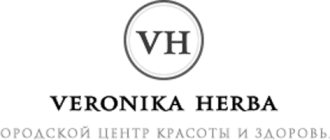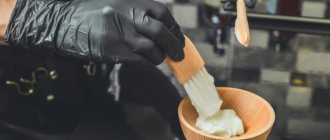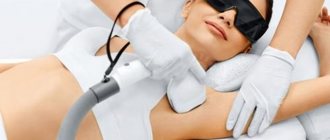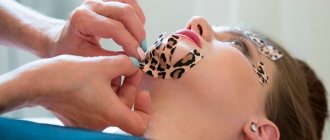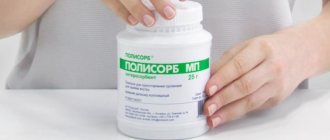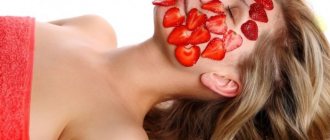No matter how thorough the basic facial care is, you cannot do without additional help. What is meant by additional help for our skin? That's right - this is a face mask that can solve cosmetic problems and even have a therapeutic effect. In addition, modern cosmetic masks can work wonders. But it must be selected and used correctly so as not to cause harm. Therefore, we will reveal the main principles of mask care.
- Why is it necessary to do face masks regularly?
- Cosmetic face masks: classification
- Consider the purpose of face masks
- Frequency of use of face masks
- Which face masks are effective in the morning and which in the evening?
- Basic principles of applying a face mask
- Are face masks compatible with each other and is it possible to make several at once?
- Is it possible to combine a face mask and scrub?
Why is it necessary to do face masks regularly?
Face masks are associated with fruit and vegetable mix (that was in the refrigerator) or clay covering. After all, a mask is needed to saturate the skin with vitamins and beneficial minerals, and you can make it at home yourself. Yes, that's right! But recently a real boom from South Korea has come to the world of cosmetology. Nowadays, Korean cosmetics are very popular. Products from their Japanese counterparts are not inferior in quality and demand. But the main Asian heritage is face masks.
This is an effective quick-acting remedy for healing and nourishing the skin. Every woman who wants to preserve youth and beauty should make masks. And here's why you should regularly do this pleasant procedure:
1. Industrially produced cosmetic masks contain a complex of high concentration active ingredients that are not found in homemade products. And these elements work more actively and penetrate deeper into the layers of the dermis.
2. This is a salvation from any cosmetic problems. Depending on the type, masks can reduce rashes, excessive oiliness or dryness of the skin; prevent signs of aging or smooth out fine wrinkles; even out complexion and eliminate age spots.
3. The mask intensively nourishes and moisturizes the layers of the dermis. No, don’t forget about the water regime - a lack of water in the body leads to dryness and flaking of the skin.
4. Cleanses pores and dermis from impurities, fat, bacteria and even harmful substances. At the same time, the pH balance and proper microflora of the skin are normalized.
Helps restore the dermis and protect against external negative factors.
5. This is an express care product when you need to quickly get your skin in order - before an important event or, conversely, after a hard day at work. It will give you freshness and a rested look after the first use.
But masks are cumulative.
If you do them on an ongoing basis and regularly, the condition of your skin will be much better. But if there is oversaturation, it will have the opposite effect.
What is a good mask for facial rejuvenation at home?
To keep your skin young for as long as possible, stop smoking, removing freckles, and bleaching your skin. Constant weight gain and loss also makes a negative contribution. When going outside on a sunny day, apply a special protective product. Tan with caution. Due to these manipulations, the skin loses moisture, becomes dry and flabby.
You can rejuvenate your facial skin at home; you don’t have to visit a beauty salon. For example, you can do rejuvenating massages that refresh the skin and relax the muscles, which leads to good results.
The advantages of anti-aging procedures at home are obvious:
- You can prepare scrubs, peelings and masks yourself;
- They are often prepared from ingredients that every housewife has in her kitchen;
- Peels and masks for facial rejuvenation, prepared at home, are completely natural;
- They do not contain preservatives, stabilizers and other “yucks” that commercial cosmetics are often filled with.
It turns out that homemade masks for facial skin rejuvenation are more effective and allow you to save a lot of money that would have to be spent in a beauty salon. Pay attention to the composition of cosmetics, even very expensive ones: not a single mask will contain 100% natural ingredients, so prepare them at home. Then you will definitely be sure of achieving the desired result.
You need to start by drinking at least one and a half liters of still water every day. Buy bottled water, then you will know exactly how much you drank during the day. Green tea without sugar can also replace some of the water.
It is important to eat well and balanced. Pay attention to what you eat. Be sure to consume carotene, fiber and vitamin A.
In any case, if you decide to rejuvenate at home, you cannot do without folk recipes.
Recommended articles on the topic:
- Facial mesotherapy procedure: pros and cons
- Beauty injections: types of drugs, reviews
- Placental therapy is the secret of eternal youth
Consider the purpose of face masks
1. Everyone, without exception, needs moisturizing face masks. The composition uses hyaluronic and lactic acid, plant extracts. They fill the dermis with moisture.
2. Nourishing masks are rich in vitamins, amino acids and minerals. The composition often contains beekeeping products and plant components. Girls with oily skin should use them with caution.
3. Toning – make the skin radiant, velvety and rested. The composition contains extract of lemon or other citrus, rice and black caviar (it is also well known as an anti-aging component).
4. Cleansing – remove dead skin cells and cleanse pores. The composition is dominated by healing mud, clay or charcoal.
5. Soothing masks are ideal for sensitive skin. They protect and restore the dermis after ultraviolet radiation or other negative external factors. The composition contains components such as chamomile, green tea or aloe vera.
6. Whitening masks even out facial tone and reduce age spots. The composition contains retinol, vitamins C and E. It is not advisable to use it for dry, sensitive dermis or if there are rashes.
7. Anti-aging masks only for aging, mature skin after 30-35. The composition contains collagen, placenta, nanoparticles of beneficial minerals and animal extracts (for example, snake or bee venom) to improve skin elasticity and prevent/smooth out wrinkles.
The best store-bought care creams
In stores and pharmacies you will find hundreds of products, for example, the following popular mid-priced products:
- Bioderma Atoderm Intensive Baume Facial Balm. Product for dry and sensitive skin. Absorbs for a long time, has a pleasant smell, nourishes, moisturizes, and does not cause allergies. Contains sunflower oil.
- La Roche-Posay CICAPLAST BAUME B5 SPF50. Suitable for normal skin. Contains no fragrance, does not cause hyperpigmentation, and has SPF 50.
- Librederm SERACIN Mattifying Day Cream For Oily Skin Seracin. Mattifying composition for oily skin. The product adsorbs sebum and normalizes the functioning of the sebaceous glands. Moisturizes, relieves redness, prevents acne. Contains burdock extract, gulyavnik extract, hydroacid, zinc salt.
- Natura Siberica Day face cream. Product for oily and combination skin. It has a mattifying, nourishing, moisturizing effect, and has SPF 15. The product contains phytopeptides, hyaluronic acid, vitamin C. At first, a slight tingling may occur upon application.
- Black pearl Self-rejuvenation 36+. Suitable for sensitive skin. Promotes the production of its own molecules of collagen, elastin, hyaluronic acid. Distributes well, moisturizes, evens out tone.
- AVENE Cleanance HYDRA. Suitable for problem skin. Helps with acne, nourishes, moisturizes, removes oily sheen.
After the masks, you should apply cream in accordance with your dermatological characteristics.
The cost of creams ranges from 250 to 1500 rubles. The ideal drug for you may be in both the economy and premium segments.
Which face masks are effective in the morning and which in the evening?
Korean women are sure that masks should be done not only in the evening. They often use cloth face masks in the morning. This way they saturate the dermis with moisture, which allows the skin to glow all day long. Therefore, in the morning, instead of cream or gel, apply a moisturizing mask - it is quickly absorbed and does not leave stickiness. Choose a product with aloe, snail mucin or hyaluronic acid.
In the evening, start cleansing and eating. Korean women love night masks, because at night, during rest, the skin itself renews itself and absorbs nutrients more actively. But you can make such a mask once a week (for aging skin, 2 times are acceptable). After the evening mask, secure the result with a light cream or emulsion. But do not overload your face with masks and creams with active ingredients!
Evening - for cleansing and nutrition
After 6 pm and before 9 pm is the best time for such procedures.
In the evening, dry and normal skin wants cleansing, hydration and nutrition. Oily - cleansing and treatment.
Any skin will benefit from evening masks made from vegetables and fruits, which have a soothing, anti-inflammatory, and whitening effect.
Apricot compounds soothe, zucchini, eggplant relieve inflammation, tomatoes rejuvenate. For such masks it is better in the evening, as there may be slight skin irritation.
A well-chosen and timely mask will help you have a great day.
Is it possible to combine a face mask and scrub?
It would seem a simple question, and many girls are accustomed to making a face mask only on thoroughly cleansed skin. Those. after washing and scrubbing. But not everyone knows about this scheme, and there are small insidious nuances.
1. Remember - the scrub must be done before the mask, otherwise you can damage the dermis! And the effect of the mask decreases in the reverse order.
2. The scrub dries out the skin. Although peeling is gentler, the skin after mechanical cleansing needs hydration, nutrition or soothing agents (depending on skin type).
3. Do not use drying or cleansing masks after the scrub - the skin will be overdried.
4. The same rule applies to film masks. There should be at least a week between these two procedures!
How to apply a mask for facial skin rejuvenation
Applying a facial rejuvenation mask should be done in a calm environment. A cosmetologist should have warm hands and communicate with the client slowly. A cosmetic mask is a whole ritual, and not just a facial skin care procedure.
The client should relax, feel refreshed from daily tension and stress. If this does not happen, then do not count on the desired effect.
Trust your face only to professional specialists, because it is very important to choose the right composition of a mask for facial rejuvenation and determine the condition of the skin.
A specialist will definitely check whether you are allergic to any components included in the facial rejuvenation mask. This is easy to do: a small amount of the product is applied to the extensor surface of the forearm. If after 10 minutes a burning sensation, redness, or itching appears, then the mask should not be applied to the face.
In addition to checking for allergies, the technician should ask whether the patient suffers from claustrophobia. If yes, then you should not choose masks that harden and compress the soft tissues of the face. This can cause a feeling of enclosed space, as a result of which the client will begin to panic and there will be no effect from the procedure. These masks include paraffin, lifting and alginate.
You cannot immediately apply a face rejuvenation mask. The skin is first cleaned with a hot compress or vaporization, that is, a stream of steam mixed with ozone. Both methods open up the pores. Steam also kills microorganisms.
You should not always moisturize the skin, but only if it is prescribed in the instructions for use of the mask. Not all medications can be applied to the eyelids and the area above the upper lip. If, however, the composition of the facial rejuvenation mask is suitable for such areas, then special tampons moistened with lotion or chamomile decoction are placed on the eye area. Then the composition will definitely not get into your eyes. Getting a mask into your nose is also unacceptable.
The mask is applied from bottom to top along massage lines: from the chin to the earlobes, from the corners of the lips to the middle of the auricle, from the nose to the temples, then from the middle of the forehead to the temples. The figure shows these directions:
To apply a mask to rejuvenate facial skin, you need various tools: spatulas, special brushes that resemble makeup brushes, but are stiffer, flatter and wider. In rare cases, a specialist applies the mask with his hands. A sterile spatula is needed in any case: it is used to remove the required amount of the finished composition from the jar. In some beauty salons, the ingredients of the mask are mixed right before application, in which case the cosmetologist determines the required volume in advance. It is better to use disposable containers, spatulas, and sponges for rinsing.
The mask is applied in a fairly thick layer for 10-40 minutes in accordance with the instructions. The client should not talk or laugh during this time.
There is no need to stretch the skin when washing off the mask. You should use cotton swabs or sponges moistened with cool water if the skin is oily, and warm if dry. Gels and foams for washing are not recommended. If the facial rejuvenation mask dries out some time after application, soak it with water and then carefully wash it off without damaging the skin.
Keep in mind that you can apply cosmetics only two hours after the procedure, and preferably 3-4. Only a light moisturizer is allowed.
And yet, what is the result of applying a mask to rejuvenate facial skin?
- Relieving facial skin from environmental stress;
- Enriching the skin with moisture;
- Improving blood circulation and lymphatic drainage;
- Improved appearance: tightened oval face, giving the skin freshness and velvety, reducing pores;
- Saturation of the skin with nutrients;
- Regulation of the secretion of the sebaceous glands;
- Relieving irritation and inflammation;
- Improved mood and self-esteem.
What our skin needs at different times of the day
Biorhythms are expressed in the difference between daytime and nighttime processes in the skin.
Knowing the daily rhythm, it is easy to determine what time is best to do a face mask, and when you should refrain from doing it.
The daily cycle is divided into the following periods:
- 5.00-7.00. Preparing for the day's activities. The endocrine glands actively release hormones into the blood, sugar and hemoglobin levels rise, and blood pressure increases. Metabolism and cell division, on the contrary, slow down. It is best to make light toning and moisturizing masks.
- 7.00-8.00. Activation of the cardiovascular system. In the morning, blood circulation increases, blood flow to internal and external organs increases. If you slept well, you will look especially fresh at this moment. The best thing to do around seven in the morning is take a shower.
- 8.00-10.00. Increased pressure. The skin of the face becomes sensitive to cold and especially thermal influences. The body accepts medications well, and you can also make moisturizing masks. Massage will have a particularly beneficial effect.
- 10.00-13.00. Blood rushes to the digestive organs. Sebum (sebum), which the sebaceous glands produced at night, just reaches the surface, forming a film. Now it’s good to make masks aimed at eliminating acne. If you have sensitive skin, cosmetic procedures during these hours will be especially easy to tolerate.
- 13.00-15.00. Capillary pressure and nutrient flow are reduced. At the same time, skin tone decreases, complexion deteriorates, wrinkles and other defects appear. The skin experiences real afternoon fatigue. Now you can make a toning or moisturizing mask, but don’t expect any special miracles. Perhaps the best thing to do at this moment is to take a walk in the fresh air.
- 15.00-17.00. All biochemical processes in the body slow down. The epidermis becomes immune to any procedures and insensitive. Anesthesia performed during this period will be most effective.
- 17.00-20.00. After the stress experienced during the day, the body feels a new surge of strength. The skin responds well to nourishing and cleansing compositions, scrubs, and peels.
- 20.00-22.00. Preparation for sleep. It is useful to apply a night cream or a night mask with vitamins, minerals, and components to stimulate regeneration.
- 22.00-23.00. If you go to bed during this period, the next morning you will feel full of energy.
- 23.00-5.00. Recovery. Blood supply to tissues increases, sebum production occurs. You should not make masks, with the exception of formulations that can be left overnight.
Use on dirty or clean hair?
Which hair is best to apply on - dirty, clean, or it doesn’t matter which one?
After washing with shampoo, the keratin scales of the hair open, which allows nutrients to more easily penetrate into the cells. And the main components of the masks cover some of the scales, making the hair shiny and smooth. Therefore, experts recommend applying the products to washed and slightly damp hair. Only masks prepared with oils can be applied to dry, dirty strands, since their residues are quite difficult to wash off and make the hair greasy; in other cases, apply to clean hair.
It is better to apply home-prepared compositions to slightly damp and dirty hair - in this case, the components of the mask will lie more smoothly and be absorbed faster.
IMPORTANT: you can massage the scalp while applying the mask only when it is washed. Otherwise, styling products and dirt will penetrate into the skin cells. Now you know when it is better to apply - before or after washing your hair
Now you know when it is better to apply - before or after washing your hair.
Regular cleansing of the scalp from dead cells and fat improves the flow of oxygen and also softens the hair structure. Therefore, it is advisable to apply masks after peeling, because... at this moment, the tone increases, cellular metabolism is activated, and the hair roots receive nutrition due to the acceleration of blood supply. This complex effect helps solve the following problems:
- hair loss;
- dermatological diseases;
- violation of fat metabolism.
Essential oils, which can be added as an additional component to masks, also improve the condition of hair. In this case, the dense composition of the mass fills the cavity between the scales and solves the problem of split ends and brittle hair.
You now know, including how to apply it correctly - before or after washing your hair. As you can see, in some situations it can be done on clean hair, and in others on dirty hair.
How long to keep?
We told you how to use a hair mask. How long should you keep it? Often, the instructions for store-bought products indicate the recommended time of contact with hair. And on average it takes no more than 15 minutes. After this period, the mask is simply washed off with warm, but not hot water. An additional cold rinse procedure “seals” the cuticles, preventing hair from losing moisture. Dry clean strands with a towel and do not blow dry them.
Oil masks are washed off with plenty of water and gentle shampoo, otherwise the curls will become greasy and look unkempt.
As for homemade masks, the duration of their contact with the hair depends on the composition.
| Main components of the mask | Duration of use |
| Pepper tincture, pepper, onion, garlic, mustard, henna, horseradish and other aggressive ingredients that dry out the skin and hair structure | No more than 30 minutes |
| Essential oils | Will not cause harm even if left overnight |
| Honey, eggs | From 30 minutes to several hours |
| Gelatin | From 60 minutes to 2-3 hours |
It is worth noting that products with honey, egg and gelatin are washed off only with cool water, otherwise they are difficult to remove from the hair. To remove the unpleasant odor from some ingredients (onions, garlic, etc.), it is recommended to add a few drops of lemon juice to the rinse water. Tinctures and herbal decoctions intended for rubbing into the roots do not need to be washed off.
Recipes for homemade mixtures consist of an available set of ingredients, but before use you should find out how safe they are and whether they will cause allergies.
Initially, it is recommended to apply a few drops of the mask to your wrist and, if irritation does not appear within a few minutes, then you can safely act.
Pay special attention to the time the product is left on your hair - do not improvise and follow the recommendations, otherwise some aggressive components may damage your curls. You should also immediately wash off the drug if there is a feeling of itching, burning, etc.
5.Rejuvenation
Youthful skin is the cherished dream of many women. Anti-aging face masks will help take care of this. Anti-aging masks can prolong the youth of the skin , increase its elasticity, “tighten” the facial contour and smooth out wrinkles .
Anti-aging face mask PURE LINE is effective against the main visible signs of skin aging. The composition of the mask includes a complex of natural oils, as well as boreal red maple extract. Red maple bark is rich in microelements (magnesium, zinc, phosphorus, calcium), vitamins A and B, tannins and antioxidants.
The PURE LINE mask smooths out wrinkles, removes toxins, intensively nourishes and saturates the skin with moisture..
Boreal Red Maple Extract
What is the best face cream suitable for winter?
A wide variety of tests in recent years have shown that a good face cream does not have to be expensive. Even cheap products do what they promise and can sometimes even outperform luxury face creams.
Which face cream is better to choose for winter – moisturizing or nourishing?
Is it possible to use facial moisturizer in winter? This question is often heard by cosmetologist O.V. Zhukovskaya.
“While lightweight gels and lotions are ideal for summer skin, you should be careful with creams with a high water content. Because on a windy, frosty day, the water freezes and lies on the skin like ice. This gradually enlarges the blood vessels, which manifests itself as constant redness of the cheek, which disappears only with laser treatment,” says Oksana Vladimirovna.
Since the water in moisturizers can freeze on the skin, it is recommended to use a nourishing cream with an oil or lipid content of at least 50%
Composition of face cream in winter
The ideal cream for the cold season contains a higher oil content and moisture-binding hyaluronic acid. Cosmetologists recommend looking for the following nutritional ingredients in winter care creams:
- urea – penetrates the skin and binds water;
- glycerin - designed to protect dry, cracked and itchy skin, penetrates it, and also lies on the surface as a slightly oily protective film. This prevents moisture evaporation and helps retain it;
- Evening primrose oil – softens flaky and very dry skin;
- linoleic acid – prevents dryness and roughness;
- almond oil – useful for very dry and flaky skin;
- Avocado oil – promotes cell regeneration and is especially suitable for caring for dry, cracked skin;
- wheat germ oil - ideal for particularly dry skin because it has unique moisturizing properties;
- hyaluronic acid – good for retaining moisture, strengthening the outer layers, softening and smoothing;
- argan oil – soothes chapped, dry skin;
- shea butter – indispensable for dry and dehydrated faces;
- panthenol – protects against irritation;
- vitamins A – promotes blood circulation;
- Vitamin E – makes the skin elastic and strengthens its protective properties.
All creams must be applied to the face and neck at least half an hour before going out into the cold, otherwise you risk getting hypothermia of the skin.
Don't forget to apply the cream to your neck and décolleté!
Be sure to use a humidifier in winter and try to drink more water!
How to use:
- Apply the cream in a small amount (the size of a pea) with light movements of your fingers, so that it is absorbed by itself. The rule “the more the better” does not work in this case: the skin will not absorb more cream than it is capable of.
- Do not rub the skin; any intense rubbing leads to stretching and wrinkles.
- If you apply a lot of cream, be sure to blot off the excess with a napkin.
Protective face cream against cold and frost
If you spend a lot of time outside in cold weather, for example, during winter sports, then you need to protect your facial skin with special waterless creams. This also applies to sensitive skin.
The wind enhances the effect of the cold, so even if in winter the temperature in your area is above five degrees, but it is windy, you will need a protective face cream.
How to use:
- apply protective cream in a thin layer;
- do not use it daily;
- wash it off after spending time outdoors.
Protective winter face cream clogs your pores too much. If you apply it thickly and often, the skin will not be able to breathe properly, and sweat will stop evaporating. The result is a moist environment that is nutritious for bacteria and fungi.
Sunscreen for face in winter
Sun protection is also important in winter, especially in the mountains: even when the sun is hidden behind the clouds, due to the height and reflection from the snow, exposure to UV rays becomes more intense.
If you need sunscreen, you can combine it with daytime cream and apply it on top.
In the cold season, use a cream with at least 15 sun protection factor, and preferably 30-50. UV protection products should be applied at least fifteen minutes before going outside.
Vaseline for the face in winter
In the past, Vaseline was a popular means of protecting the skin from frost. It is made from petroleum waste and is one of the oldest and most widely used paraffinic hydrocarbon products. This product has a side effect: it clogs her pores so much that she can no longer breathe. However, Vaseline is no longer relevant, since there have long been good alternatives in the form of modern creams with harmless natural ingredients.
